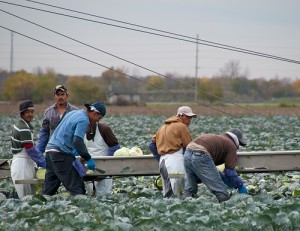Celebrating Chávez Monument, But Where Are Farm Workers Now?

 By Ivan Delgado, Aurora Saldivar, Johnny Flores, New America Media
By Ivan Delgado, Aurora Saldivar, Johnny Flores, New America Media
KEENE, Calif. — On October 8, 2012, over 6,000 people descended upon Villa La Paz — the home, operational headquarters and final resting place of civil rights and labor leader César Chávez — for President Barack Obama’s dedication of the César Chávez National Monument. They came from throughout the country to see this 187-acre property in the foothills of the Tehachapi Mountains take its place among national monuments such as the Statue of Liberty and the Grand Canyon.
Although the dedication was celebratory in tone, many in attendance acknowledged that the dreams Chávez had for farm workers — such as fair wages, safe working conditions, job protection, dignity and respect — have not been entirely fulfilled.
 Estimates put the number of seasonal and migrant farm workers in the United States at more than 3 million, and while farm workers form the backbone of a national agriculture industry that isprojected to generate more than $222 billion in crop sales in 2012 alone, many of those who toil in the fields — more than four decades after the formation of the UFW — continue to live an impoverished life in the shadows of society, collecting low hourly wages and sometimes paid by the piece, or amount, of produce they can harvest.
Estimates put the number of seasonal and migrant farm workers in the United States at more than 3 million, and while farm workers form the backbone of a national agriculture industry that isprojected to generate more than $222 billion in crop sales in 2012 alone, many of those who toil in the fields — more than four decades after the formation of the UFW — continue to live an impoverished life in the shadows of society, collecting low hourly wages and sometimes paid by the piece, or amount, of produce they can harvest.
As recently as 2009, 23 percent of farm worker families were found to have a total household income below the national poverty guidline.
Sub-standard housing continues to be a chronic issue for farm workers, in particular migrant workers who travel to keep up with regional crop harvests. In a 2007 survey conducted among migrant workers based in the Coachella Valley, 30 percent of workers surveyed reported living in housing “not meant for human habitation” — camping outdoors, living out of their automobiles or converted, overcrowded garage spaces.
Despite the obvious challenges that remain, the unveiling of the the Chávez National Monument in Keene and the emotional response of those who bore witness to it, were a reminder that the hopeful spirit embodied in the UFW rallying cry, sí se puede (yes, it can be done), remains present in the hearts and minds of many Californians.
This article was first published in New America Media.
The slideshow was produced by youth reporters from Coachella Unincorporated, a community and youth-led news outlet founded by New America Media to serve residents of the Eastern Coachella Valley, the fifth largest agriculture producing region in the nation and home to many farm worker families. Coachella Unincorporated is supported by a grant from The California Endowment.
[Photos By Bob Jagendorf, richmooremi]
